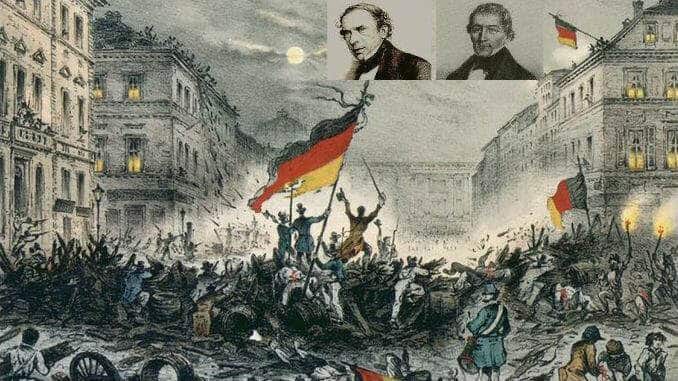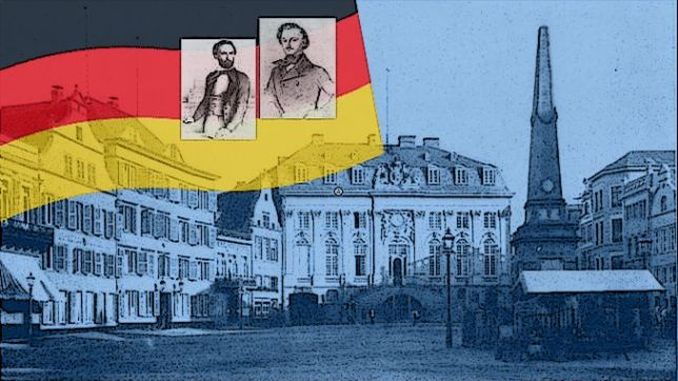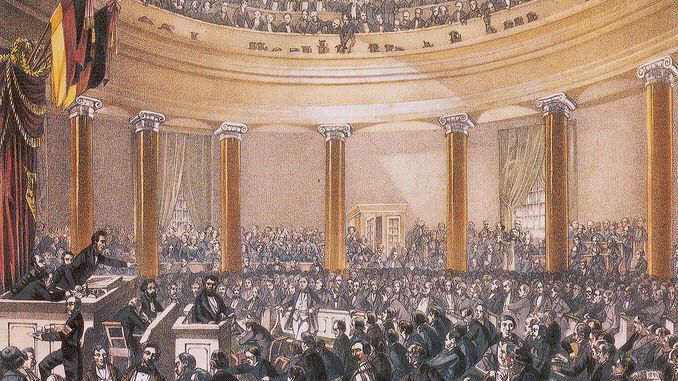
Germany, 1848, the year of the Revolution of 1848/49. The news about the February Revolution in France had spread quickly. Already in the first days of March, people throughout Germany had taken the streets, waving black-red-golden flags, demanding unity, freedom of the press, freedom of assembly and the right to form armed militias.
March 1848
Moreover, Germany should become a united nation, with a national parliament that would represent all the citizens, not only the monarchs, the “German Federation”.
Nonetheless, most Germans preferred a peaceful transition and would accept a constitutional monarchy. Caught by surprise and off guard, the rulers of the small and medium German states gave in. They even appointed liberal ministers, the “March ministers”. Similarly, the Federal Convention, the central institution of the German Confederation, released press censorship and declared the colors black-red-golden as the national flag.
In Vienna, Chancellor Metternich, who stood for restauration and oppression, had to resign and flee to London.
Barricade fights in Berlin
When news of the revolutionary events and Metternich’s resignation reached Berlin, many people took the streets. Then troops marched in and tension rose. King Frederick William IV was well aware that his crown was in danger. Yet, he decided, against the hardliners among his advisors, to make moderate concessions.
On March 18th, a large crowd gathered in front of the Royal Palace at Berlin and cheered the king as he stepped out onto the balcony. Soldiers tried to push the people back. Suddenly, two shots were fired, whether deliberately or accidentally, has remained unclear to this day. Immediately the mood swung, and all night long until the early hours of March 19, barricade fights raged in Berlin, killing hundreds of people. The cause of the revolutionaries was almost lost, yet the King did not want any more bloodshed and ordered his troops to retreat. Prince Wilhelm, the later Kaiser Wilhelm I, did not share his brother’s attitude. Had it been up to him, the “rebels would have been shot with cartridges”. The King first sent him out of the country to England.
The artist Adolph Menzel has captured the next day in a history painting., the Laying Out of the Fallen March revolutionaries.Two days later, on March 21, 1848, the King rode through the streets of Berlin wearing a black-red-gold bandage.
Thereafter, on 29 March 1848, Friedrich Wilhelm IV formed a new cabinet with two liberals from the Rhineland, Ludolf Camphausen and David Hansemann. That was extraordinary, a commoner from the Rhine Province at the top of the Prussian cabinet! Nonetheless, the Prussian crown also benefited, as the two gentlemen were wealthy entrepreneurs.

Bonn 1848
In our region there were democratic clubs too. At Bonn University, professor Gottfried Kinkel from Oberkassel and his student Carl Schurz from Liblar had become friends, they founded the “Bonner Zeitung” and advocated democratic reforms.
National Assembly in St. Paul’s cathedral, Frankfurt
In March 1848, the revolution had won. A prototype parliament called for free elections for a National Assembly for all of Germany. On March 18, 1848, the National Assembly opened its first session in St. Paul’s Church, Frankfurt. It was a big, day, all around the church people waved black-red-golden flags and cheered for the parliamentarians. Among them were Jakob Grimm and Ernst Moritz Arndt.
The National Assembly certainly had to face tremendous tasks. Its standing, however, was low from the start. The old forces, above all the big powers Prussia and Austria, had given in only for the moment. Similarly, they acted as if the National Assembly did not exist. There was nothing that the National Assembly could do except protest, since it had no executive power. While the National Assembly discussed a new constitution, it was overtaken by reality. The fights continued and the old powers regained territories and might.

Troops against democrats
In November 1848, Count Schwarzenberg crushed the revolutionary movement in Austria and restored absolute monarchy. Francis Joseph I (in German Franz Joseph, 1848-1916) became Emperor. Robert Blum, a member of the National Assembly, was in Vienna to encourage the republicans. In those desperate days, he got involved in street fights and was arrested. In defiance of his immunity as a member of the National Assembly and all the protests, he was executed on November 9, 1848.
Meanwhile, troops marched into Berlin, and the old powers regained control. Frederick William IV appointed a new cabinet that consisted of conservatives only. On December 5, 1848, he imposed a constitution of his own. It provided for a two-house-parliament. The king appointed the upper house, the Herrenhaus (“House of Lords”). The lower house, the Landtag, was elected by all male taxpayers. Yet, their votes did not have the same weight. According to the amount of taxes paid, the voters were divided into three classes. As a result, the few voters with a high income, and therefore a considerable amount of taxes paid, had a lot more political influence than large parts of the population with little or none income.
No crown “disgraced by the stink of revolution”
In March 1849, the National Assembly had finally finished its work. The “Basic Rights for the German People” proclaimed equal rights for all citizens before the law. Germany should become a constitutional monarchy with the Hohenzollern dynasty of Prussia as emperors. On April 2, 1849, a delegation of the National Assembly travelled to Berlin and offered the crown to Frederick William IV. He turned it down in a polite, but unmistakable way. He, who believed that his was king by the grace of God, could never accept receiving the crown from the people. “A crown from the gutter, disgraced by the stink of revolution, defiled with dirt and mud”, as he wrote in a private letter to England.
Schurz and Kinkel join the revolutionaries
The National Assembly was forced to dissolve in 1849. A second revolutionary wave went through Germany. In Saxony, Baden, the Rhineland, Westphalia, and the Palatine, democrats took up arms again to force the monarchs to accept the constitution.
Schurz, Kinkel, and others from the Bonn community were among them. In the night of May 10/11, 1849, they both marched at the top of 120 citizens to the arsenal in Siegburg, to get weapons. But the operation failed, Kinkel and Schurz had to flee. They joined the revolution in the Palatinate and Baden.
Prussia sent an army commanded by Prince William. The revolutionary fought several battles, but they were no match for the skilled Prussian troops. Kinkel was wounded and taken prisoner. Eventually, the revolutionaries, among them Schurz, only held the fortress of Rastatt. The Prussian army besieged it, and they had to surrender to avoid more bloodshed. As a Prussian citizen, Schurz had to face a death sentence, but he had a narrow escape.
Forty-Eighters
In 1850, Schurz returned secretly to Prussia and rescued Kinkel from prison at Berlin-Spandau, they both escaped to Edinburgh, Scotland. Later Schurz went to Paris, but on the eve of Napoleon III’s coup d’état in December 1851, revolutionaries were no longer welcome to France. The police forced him to leave the country.
Schurz then went to London. There he met Margarethe, who became his wife. In August 1852, they emigrated to the United States. Margarethe opened a kindergarten in Watertown, the first in the United States. Carl Schurz became an accomplished journalist and later American statesman and reformer, almost friends with President Lincoln, and Secretary of the Interior under President Rutherford B. Hayes.
Read more about him in my emigrants’ story “At home at the Rhine and in America”.
Back then, many disappointed German patriots went to the United States. Besides Schurz, some of the best known are Franz Sigel and Friedrich-Hecker. They became known as Forty-Eighters.
Kingdom of Prussia and German Reich
Intro Prussian Rhineland | Prussian Rhine Province | Revolution 1848/49 | Bismarck Era | Wilhemine Era

Be the first to comment